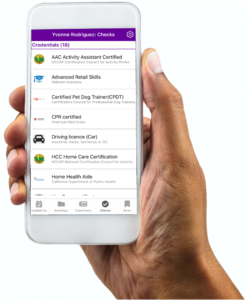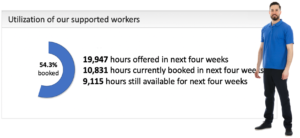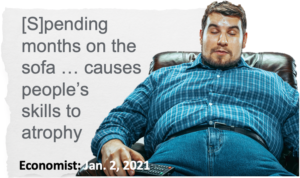 A comprehensive platform that is finding each person work at the precise times they need can seamlessly incorporate upskilling. That integrates data, responsiveness, and best uses of everyone’s time.
A comprehensive platform that is finding each person work at the precise times they need can seamlessly incorporate upskilling. That integrates data, responsiveness, and best uses of everyone’s time.
Data-driven training
Empowering non-standard workers requires data that maximizes individual options: for progression. Queries such as “What percentage of carpet layers booked last week within 5 miles of City Hall were also qualified as plasterers and how did their payrates compare to electricians?” can be answered instantly by a platform like GoodFlexi.
A crucial datapoint is utilization; the ratio of hours offered to hours worked. If you have 20 hours you want to work this week and get 15 booked, you have 75% utilization.
Utilization can be measured across any combination of types of work, geographiy, and work-seeker characteristics. (“What was the utilization of call center agents younger than 30 in the east of our city over the last 6 months?”) Transitioning people from low-utilization skills to those that are in demand can become uniquely precise. Data about each individual is also newly granular. Key metrics include reliability (what percentage of bookings they confirmed did they complete, evidenced by timesheet data?), times of availability, and travel area. If funding is available to move van-drivers (low utilization locally) into truck driving (high utilization) workers with demonstrable reliability who are in the right area and want to work at the most needed times of day and days of the week can be targeted instantly.
 System outputs will also identify strugglers. Who has the lowest utilization? Nor is not moving up from minimum wage despite proving their reliability? What sort of training or support would open up high-utilization skills?
System outputs will also identify strugglers. Who has the lowest utilization? Nor is not moving up from minimum wage despite proving their reliability? What sort of training or support would open up high-utilization skills?
Support for emerging models of micro-education
 Not everyone can accommodate a one or two-year college degree. Formal worker retraining has been criticized as generally ineffectual. Learning can be more effective when interspersed with related work. A range of forces are moving towards “bite-sized learning”.
Not everyone can accommodate a one or two-year college degree. Formal worker retraining has been criticized as generally ineffectual. Learning can be more effective when interspersed with related work. A range of forces are moving towards “bite-sized learning”.
This concept could be built into a comprehensive hourly labor platform, effortlessly offering facilities like:
- Digital badges: These can be applied and verified manually in a CEDAH of course. Or badges could be imported as they are awarded to workers in other systems.
- Building block modules: A candidate seeking perhaps a career as cabin crew could be prioritized for entry level bookings at a local airport that maintains a pool of top-up baggage handlers, meet-and-greeters, or aircraft cleaners. Having proved reliability as an on-call general cleaner she might merit vetting for airside cleaning and from there progress, through bookings at times she was available to work, to membership in more highly trained pools of workers.
- Micro-apprenticeships: A business with fluctuating labor needs such as an event operator could undertake to continuously train, perhaps 50 provenly reliable local work-seekers who are then prioritized for that company’s bookings at peak times. The platform could monitor progress while prioritizing the company’s apprentices for their bookings.
New on-ramps
 Many irregular workers won’t factor educational possibilities into their thinking. Planning is hard for individuals currently trapped in survival work that commoditizes and cheapens them. A publicly-run, market could push tentacles of opportunity deep into the local economy. As people come into the new market, its tools for upskilling can start working for each of them.
Many irregular workers won’t factor educational possibilities into their thinking. Planning is hard for individuals currently trapped in survival work that commoditizes and cheapens them. A publicly-run, market could push tentacles of opportunity deep into the local economy. As people come into the new market, its tools for upskilling can start working for each of them.
These options can go beyond online courses to a range of cost-effective, real-world, possibilities to tempt residents into training. Some specific capabilities:
- Ringfenced markets: The system can run sub-markets each under the control of a specialist group that sets its own rules. One example: a market for the labor of people prone to anxiety who need a support worker to accompany them for each booking. A local charity might establish a list of aware businesses then allow them to book from a pool of accompanied workers when managers have capacity.
- Early starts: High schools might use the above functionality to run a labor market, perhaps confined to Saturday daytime hours, for students 14-16. Approved households and businesses would be given access with each student free to offer hours of their choosing, keep their earnings, and build a track record before possibly transitioning, work-ready, into the wider market at 16.
- Peer support: Using market data, a body such as a workforce board could identify a pool of perhaps 100 reliable flexible workers with lived experience to be inducted as “Peer Navigators”. Any unconfident new work-seeker might then be given 10 one-hour sessions with a navigator. The system ensures they meet at home, or a public place, for structured sessions culminating in the client’s first booking through the system with the navigator booked alongside them for support. A pro-forma filled in at the end of each session within the system by the navigator tracks progress. This is an alternative to support offered by nine-to-five staff in, often remote, government offices.
 Specialist intermediaries: Commercial labor platforms focus on maximizing profit extraction and rarely accommodate intermediaries who act as employer-of-record, insurer, and champion of workers. A public platform puts these bodies at its heart. Some may be aimed at target groups, for example a support group for migrant workers that recognizes many of them need to work around family commitments. By offering the platform as one of their services, the group could enforce its protections and business model while being part of a wider eco-system.
Specialist intermediaries: Commercial labor platforms focus on maximizing profit extraction and rarely accommodate intermediaries who act as employer-of-record, insurer, and champion of workers. A public platform puts these bodies at its heart. Some may be aimed at target groups, for example a support group for migrant workers that recognizes many of them need to work around family commitments. By offering the platform as one of their services, the group could enforce its protections and business model while being part of a wider eco-system.- Investment models: Any credible body should be able to launch a labor market intervention. As an example, a charity might decide to allocate an initial $25,000 to add to earnings of workers confidentially badged as single parents up to a maximum $100 per candidate per week. A labor market platform can target, administer, and audit programs like this.
Administration for lifelong learning
 At present, poor quality matching, and the problems of scheduling study or work, drag on those needing personalized employment and training. An advanced labor market could offer tools like:
At present, poor quality matching, and the problems of scheduling study or work, drag on those needing personalized employment and training. An advanced labor market could offer tools like:
- Use of unengaged time: If someone is available to work from 2PM to 6PM today and has not received a booking by 1PM they could set a rule that those hours are to be released for other activity. Options include volunteering, networking, receiving support, or joining a class. If hundreds of work-seekers are studying, for example, to be Community Health Workers a key module of their course could be offered every afternoon for two weeks. That should allow everyone to attend while maintaining paid work as first priority. The system can tally who didn’t complete each class.
- Tailored earn-as-you-learn: Most community college students have to work while studying. In a broad, publicly-run, hourly labor market there would be more capacity to align external work with the ever-changing needs of related businesses. Students of hotel management, for example, could become a pool of top-up waitstaff, receptionists, kitchen porters and room attendants for a range of local accommodation providers.
- Fluid faculty: A college could maintain a pool of qualified trainers who are booked as students are assembled for each class by the system. And, of course, those trainers could each be offered multiple other types of work through the platform.
- Study buddies: Students who are paired to work with each other can have the system identify when they are working on the same shift or in proximity to each other. Meet-ups can then automatically be arranged around work and study commitments of both.
- Work credits: If periods of employment are made part of the requirements for course completion, the labor market platform can verify them as it would for digital badging.
New efficiencies in funding
Pockets of system data could be opened to any organization that might fund training to ensure their needs were met in the local labor market. As example, a 19 year old seeking a career in nursing might currently be working in fast food. If he was booked for that work through a publicly-run platform it would allow him to prove his reliability. That could unlock employer funding for the vetting needed to also start doing undemanding homecare bookings (assisting more experienced caregivers on bookings involving moving a client for instance).
Continuing to build a record of reliable work, he might then qualify for a publicly-funded eldercare course while the system works to get him medical receptionist or ward orderly bookings en route to a first nursing certificate. This set of steppingstones – work intermingled with learning modules – could span 5 years or more. But if his reliability earned him government- or employer – funding for each rung on the ladder it would be more finely tuned to his evolving needs than a block grant to fund a one or two-year course with little flexibility in timings, locations, or outcomes.
 If publicly-run advanced markets for hourly labor achieve deep penetration, individualized patterns of life-long learning could be woven from a variety of programs, and funding sources. The student in each case may not have full time work or study but is constantly moving upwards in line with their capabilities and willingness to work. As their skills grow, they can be increasingly selective about the work they will accept.
If publicly-run advanced markets for hourly labor achieve deep penetration, individualized patterns of life-long learning could be woven from a variety of programs, and funding sources. The student in each case may not have full time work or study but is constantly moving upwards in line with their capabilities and willingness to work. As their skills grow, they can be increasingly selective about the work they will accept.
